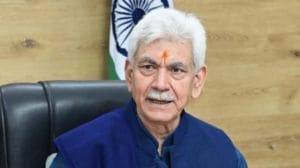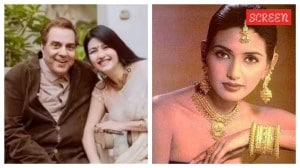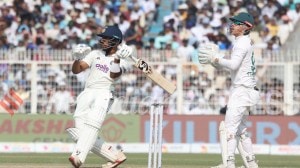The global art market churn may be good for Indian art. Art Basel Hong Kong Director’s first India visit is proof
With the majority of Indian art falling below the $10 million (high-end) segment, which is experiencing cooling, India has emerged as an ideal destination for global collectors and art fairs.
 Angelle Siyang-Le, Director, Art Basel Hong Kong, the largest art fair in Asia (Photo: Art Basel)
Angelle Siyang-Le, Director, Art Basel Hong Kong, the largest art fair in Asia (Photo: Art Basel)It is fitting that The Imperial in Lutyens’ Delhi was Angelle Siyang-Le’s first stop on her first trip to India. Sitting in the Atrium of the nearly-a-century-old hotel, with a colonial-era painting of an Indian Maharaja as the backdrop, the director of Art Basel Hong Kong (ABHK) – the largest art fair in Asia, told The Indian Express, “A big purpose of this trip is to really understand the local scene, and what the stakeholders here see as the future of Indian art.”
Soon after Angelle took charge as the fair’s director in November 2022, she had the humongous task of making the fair, which was reeling from the aftereffects of the pandemic, bounce back. It did. In its 2023 edition, returning to its full scale for the first time since 2019, the fair saw participation by 177 galleries from 32 countries.
Her visit to India earlier this month, where she followed a patrons group called Asia Cultural Council from Delhi to Ahmedabad and finally Mumbai, came against the backdrop of a plateaued participation by Indian galleries since the fair came under the aegis of Art Basel in 2016 – four in 2016, six in 2017, nine in 2018, six in 2019, four in 2023, four in 2024 and five in 2025.
While Vadehra Art Gallery, Tarq and Jhaveri Contemporary have been religiously participating through the years, erstwhile regulars like Chemould Prescott Road and Experimenter have sat out several editions. This year’s fair included two new additions – Shrine Empire and Anant Art. For Angelle, this trip was about “re-establishing these ties”. “I understand that increasingly, especially after Covid, cost has been a big issue for galleries. They do have to pick and choose and focus financially on the art fairs that they have been participating in. So we don’t take their participation for granted,” she said, adding, “What I would like to learn is how Indian galleries can further utilise Art Basel Hong Kong and be part of the community that connects the East and the West and how India would like to play a role in representing Asia as a region”
Taking stock of the global art market, which has undergone a major recalibration over the past couple of years, made Angelle’s visit well-timed. Several art market reports in 2024-25 have noted how the number of transactions in the high-end market (upwards of $10million) has seen a dip, with the volume going up in the mid-level ($50,000 – $10 million) and emerging artists (below $50,000) segment.
According to The Art Basel and UBS Survey of Global Collecting 2024, the average expenditure by High Net Worth Individuals (HNIs) went down over the last couple years, suggesting that “the majority of the decline was due to reduced spending at the higher end of the market”. Additionally, HNWIs “allocated 52 per cent of their expenditure to works by new and emerging artists, with 21 per cent on mid-career, and 26 per cent on those by established artists (the majority of which were living artists), highlighting their support for living talent.” The Art Basel and UBS Global Art Market Report 2025 further noted that the “aggregate market decline in value was driven by cooling at the top end, including a 39 per cent fall in the number of fine art works selling at auction for over $10 million”. The impact of the churn became evident when works by Andy Warhol and Alberto Giacometti failed to sell at Christie’s and Sotheby’s auctions respectively in May 2025.
 Works by Betty Muffler, presented by Ames Yavuz in the Encounters sector. (Photo: Art Basel)
Works by Betty Muffler, presented by Ames Yavuz in the Encounters sector. (Photo: Art Basel)
Indian art rarely falls in the top end. MF Husain’s Gram Yatra that fetched $13.8 million, the most expensive Indian art work to be sold at an auction, is the only work from the country that breaches the $10 million mark. With the majority of our art falling below the $10 million segment, India has emerged as an ideal market for collectors and art fairs, including ABHK, in the current times.
Add to that India’s diversity of traditions and India becomes a top contender for ABHK, “which has gone beyond being a buying and selling platform and is now focused on being a content-led fair”. “Content leads our shows rather than what is easier to sell on the market. For example, if a top-gallery is known to have weak relationships with its artists or is not contributing to their artists careers, it is unlikely for us to pick it. We also make sure there are educational elements in the show. People around the world are coming to ABHK. They should be able to learn about the art from Asia. I have come to India to really look for content and how we can create a bridge between Hong Kong and India, and between the East and the West,” said Angelle, who made stops not just at existing and past, but also potential participants (Galerie Mirchandani + Steinruecke) on this trip.
With ABHK no longer the only international art fair in Asia, Angelle also has upon her the task of holding on rather tightly to ABHK’s top position. Over the last few years, fairs like Art SG, Art Dubai, Art Busan, Frieze Seoul, Art Riyadh Week among others have cropped up. While diversifying the art scene and making the market more dynamic, the increasing number of fairs can also lead to fatigue for both sellers (galleries) and buyers (collectors), who have to pick and choose between fairs. Angelle welcomes this development as a positive for the region, but with a tad hint of caution.
“It is true that Asia, compared to America and Europe, has more international art fairs. Finally, the attention has turned to Asia and it is an opportunity for the rest of the world to understand the different cultures in Asia. There is a level of fatigue and we do have to care about the costs for galleries’ participation. That is where the uniqueness of each fair comes in,” she said, adding, “At ABHK, we now have the maximum number of booths (approximately 240) that can be carved out of the physical space we have, and we receive a lot more applications than the number of booths available. So my primary goal is to protect the gallery system – not necessarily bring more galleries into the platform – based on the top quality proposals that we receive.”
In that vein, the next edition of the fair will additionally serve as a platform that connects businesses of all kinds. “Art can also connect with other businesses in order to increase its influence. Increasing cultural influence has always been my personal goal. So I want to translate that onto the fair by giving our galleries and artists visibility and accelerating everyone’s growth,” Angelle said.





- 01
- 02
- 03
- 04
- 05


























